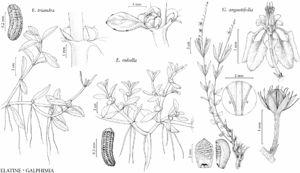Elatine triandra
Bot. Handb. 1: 345, plate 109b, fig. 2. 1789–1791.
Herbs, submersed, 2–10 cm. Stems prostrate, highly branched. Leaves light green to green; stipules triangular or ovatelanceolate, 0.7–1 mm, margins dentate, apex acute or obtuse; petiole 0–3 mm; blade linear, lanceolate, or narrowly oblong, 3–10 × 1.5–3.5 mm, base attenuate, apex acute or obtuse. Pedicels 0.3–0.4 mm, erect. Flowers: sepals (2–) 3 (–4), usually 1 reduced, ovate, 0.5 (–0.7) × 0.2–0.4 mm; petals 3, white or reddish, widely ovate or elliptic, 0.6–1.2 × 0.5 mm; stamens 3; styles 3. Capsules compressed-globose, 3-locular, 1.2–1.7 [–2] mm diam. Seeds 10–25 per locule, oblong, straight or slightly curved, 0.4–0.5 × 0.1–0.2 mm; pits angular-hexagonal, length 2–3 times width, in 6–8 rows, 16–25 per row. 2n = ca. 40.
Phenology: Flowering summer–early fall.
Habitat: Shores, pools.
Elevation: 0–1100(–2500) m.
Distribution

Introduced; Alta., N.W.T., Ont., Sask., Ala., Ariz., Calif., Colo., Conn., Ga., La., Maine, Mass., Minn., Nebr., Nev., N.J., N.Y., N.C., N.Dak., Okla., Pa., S.C., Tex., Utah, Va., Wis., e, se Asia, also in South America (Brazil), Europe, Africa, Australia
Discussion
Elatine triandra is a popular aquarium plant. Reports of E. triandra from Yukon were based on misidentification of Callitriche hermaphroditica (B. Bennett et al. 2010). Elatine triandra is a common weed in rice fields of south and southeast Asia (K. Moody 1989), thus rice farming or aquarium trade may have been responsible for its introduction.
Selected References
None.
